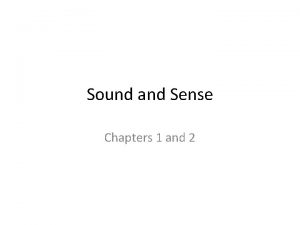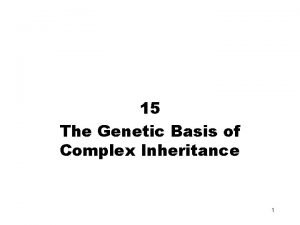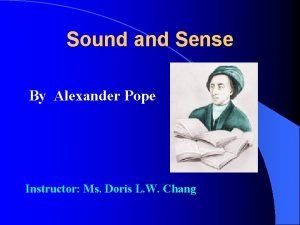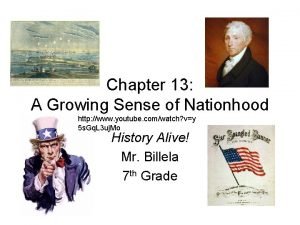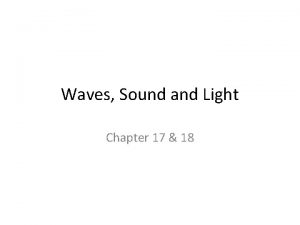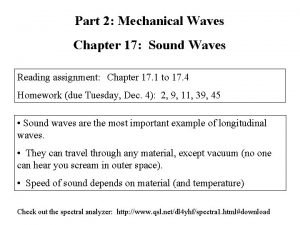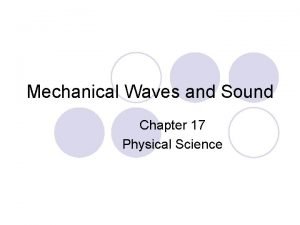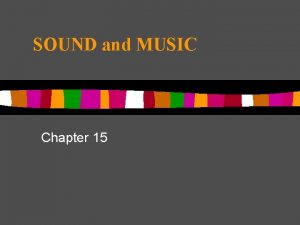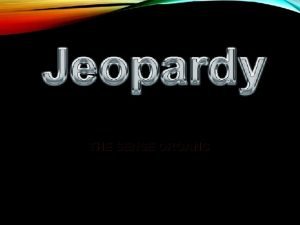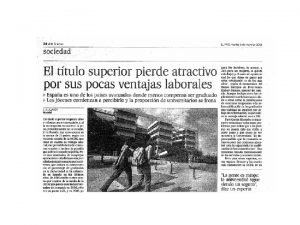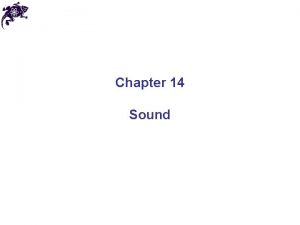Sound and Sense Chapters 1 and 2 Chapter









- Slides: 9

Sound and Sense Chapters 1 and 2

Chapter 1: What is poetry? • …a kind of language that says more and says it more intensely than ordinary language… • …to gain a greater understanding of the world… • Its function is not to tell us about experience but to allow us, through the imagination, to participate in it. • The primary concern of poetry is not with beauty, not with philosophical truth, not with persuasion, but with experience.

• In real life getting soaked in a rainstorm is not pleasurable, but in poetry it can be. • Poetry is a kind of multidimensional language. Ordinary language is one-dimensional. Poetry adds a sensuous dimension, an emotional dimension, and an imaginative dimension.

Not in your book: • Poetry is when an emotion has found its thought and the thought has found words. • Robert Frost

“The Red Wheelbarrow” William Carlos Williams (1883 -1963) so much depends upon a red wheel barrow glazed with rain water beside the white chickens 1. The speaker asserts that “so much depends upon” the objects he refers to, leading the reader to ask how much and why. The glimpse of a farm scene implies one kind of answer. What is the importance of wheelbarrow, rain, and chicken to a farmer? To all of us? 2. What further importance can you infer from the references to color, shape, texture, and the juxtaposition of objects? Does the poem itself have a shape? What two ways of observing and valuing the world does the poem imply?

Chapter 2: • To develop your abilities to understand appreciate poetry: 1. Read a poem more than once. Reading a poem is not like reading a newspaper (to gather info and put aside). It is like looking at a painting or listening to a symphony. 2. Use a dictionary not just for unfamiliar words but for words that may be used in an unfamiliar way.

3. Read so as to hear the sounds of the words in your mind. 4. Pay careful attention to what the poem is saying. 5. Practice reading poems out loud. a) Read it affectionately, not affectedly. b) Read slowly enough that each word sinks in. c) Read the poem so the rhythmical pattern is felt but not exaggerated.

• Paraphrase: means to restate the poem in different language; to make its prose sense as plain as possible • Theme: central idea • Figurative Language: Language employing figures of speech; language that cannot be taken literally or only literally

• Metaphor: a figure of speech in which an implicit comparison is made between two things essentially unlike. It may take one of four forms: (1) that in which the literal term and the figurative term are both named; (2) that in which the literal term is named and the figurative term implied; (3) that in which the literal term is implied and the figurative term named; (4) that in which both the literal and figurative terms are implied.
 Sound and sense chapter 1 answers
Sound and sense chapter 1 answers Dominant genetic variance
Dominant genetic variance Narrow sense heritability vs broad sense heritability
Narrow sense heritability vs broad sense heritability Alexander pope sound and sense
Alexander pope sound and sense 210 decibels
210 decibels “a sound mind is in a sound body”
“a sound mind is in a sound body” A growing sense of nationhood answer key
A growing sense of nationhood answer key Chapter 17 mechanical waves and sound wordwise answer key
Chapter 17 mechanical waves and sound wordwise answer key Chapter 17 mechanical waves and sound
Chapter 17 mechanical waves and sound Chapter 17 physical science
Chapter 17 physical science
